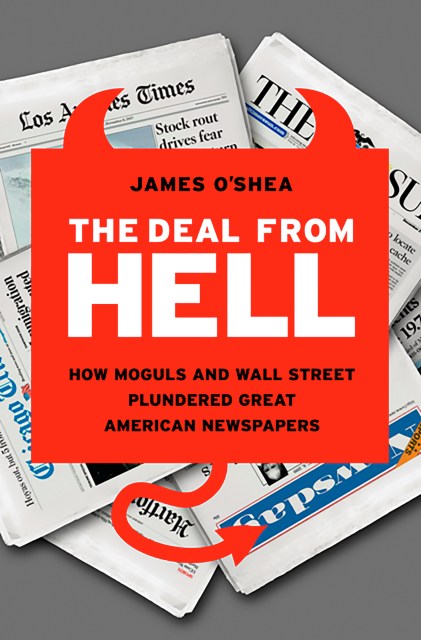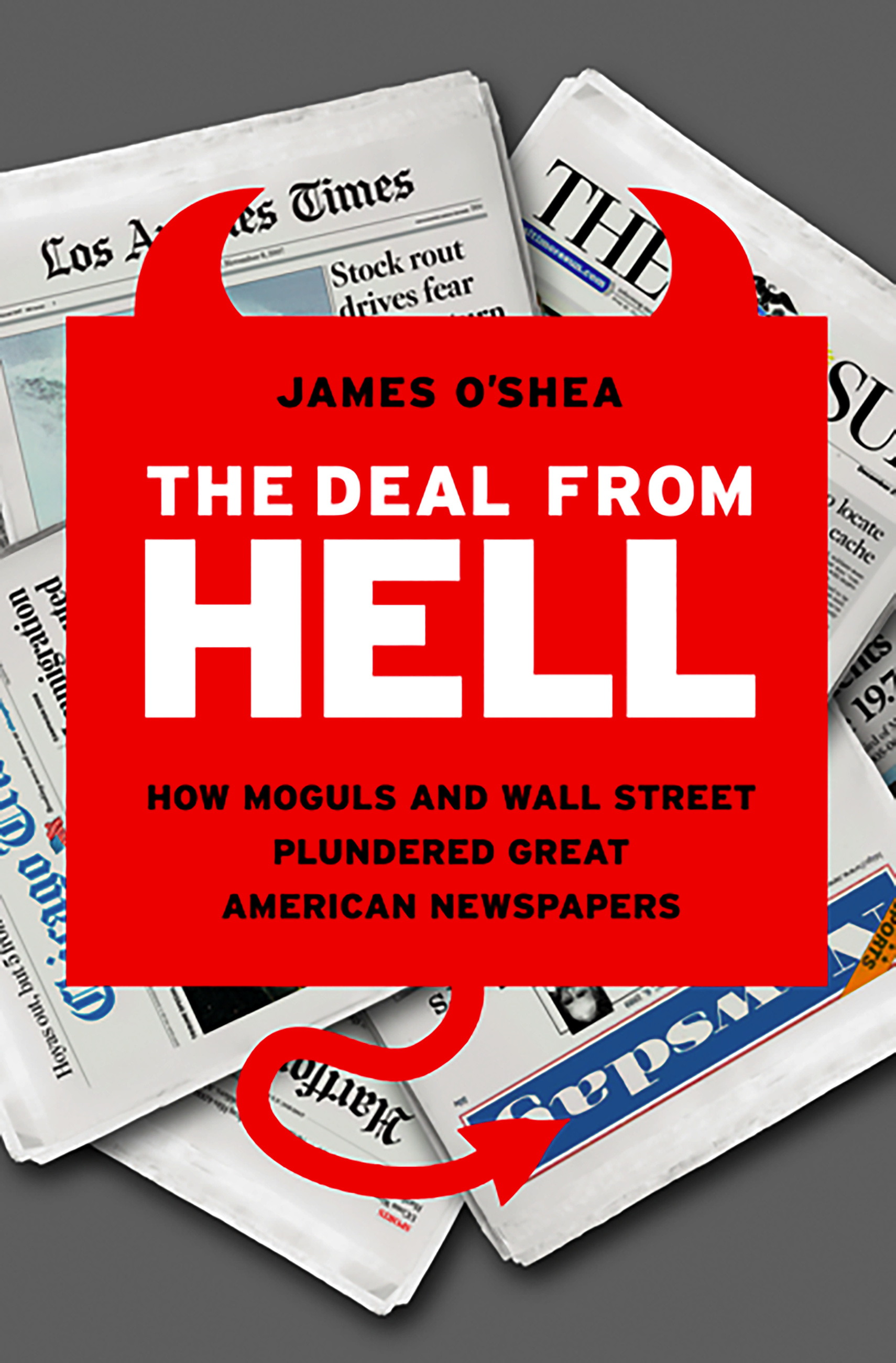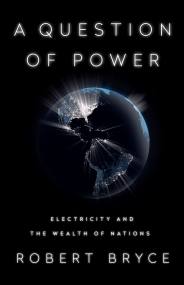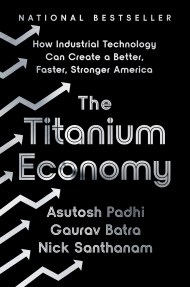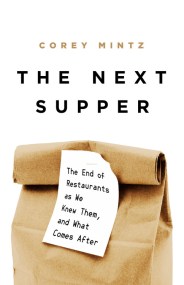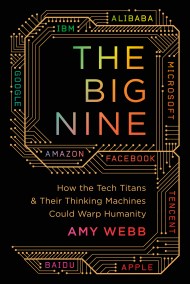Promotion
Use code MOM24 for 20% off site wide + free shipping over $45
The Deal from Hell
How Moguls and Wall Street Plundered Great American Newspapers
Contributors
By James O’Shea
Formats and Prices
Price
$40.00Price
$50.00 CADFormat
Format:
- Hardcover $40.00 $50.00 CAD
- ebook $14.99 $19.99 CAD
This item is a preorder. Your payment method will be charged immediately, and the product is expected to ship on or around June 28, 2011. This date is subject to change due to shipping delays beyond our control.
Also available from:
The Deal From Hell is a riveting narrative that chronicles how news industry executives and editors–convinced they were acting in the best interests of their publications–made a series of flawed decisions that endangered journalistic credibility and drove the newspapers, already confronting a perfect storm of political, technological, economic, and social turmoil, to the brink of extinction.
Genre:
-
“James O'Shea occupied a privileged, and unusual, seat during the [newspaper] implosion. In The Deal From Hell: How Moguls and Wall Street Plundered Great American Newspapers, O'Shea shares what he saw and heard… His book stands out, though, because of its unforgettable details about what happened to diminish great journalism at the Chicago Tribune and Los Angeles Times. The more general indictments about the newspaper industry seem like weak gruel in comparison.” Los Angeles Times, June 28, 2011“Compelling reading…His dramatic telling of the lead-up to the Zell deal that would so soon sour is staggering… In the end, "The Deal From Hell" succeeds on the force of the story and the power of the case that O'Shea builds against the individuals involved.” NewCity(Chicago alt weekly), feature, June 29, 2011“The Deal From Hell” is a candid and relatively unrestrained insider's account of the near-destruction of two of America's great newspapers. Heroes are portrayed and so, certainly are villains. Except the heroes are all gone now, and more than a few of the villains still flourish.”
-
“The Deal From Hell" is a scrupulously reported account of how hubris, bad judgment, arrogance, bad timing and, yes, greed eviscerated one of the most prestigious media companies in American history… In a class with the best books that document the Wall Street crisis of 2008, "Deal From Hell" is the best account of what has happened to newspapers in the past decade.” Publishers Weekly, July 18, 2011“While recounting how business interests sought an improper place in public service journalism, O'Shea works in fascinating and funny anecdotes that make for an excellent read. For those who want an inside look at what makes American journalism work (and not work), O'Shea offers a unique and valuable perspective.”
-
Cleveland Plain Deal, July 6, 2011
“The Deal From Hell: How Moguls and Wall Street Plundered Great American Newspapers" is a detailed, inside look at how greed, incompetence and hubris gutted two of the nation's leading newspapers…It was, indeed, a deal from hell, and O'Shea gives us a clear look at the devils involved in it. TheWrap.com, July 4, 2011
“The ‘Deal from Hell' gives us a serious and informed view of the destruction of an American journalistic institution (or two of them, in this case). O'Shea shares some fascinating inside stories based on his front-row seat as editor in chief and his long-time relationships with people who gave him interviews for the book.”Publishing Perspectives, July 5, 2011
“Mr. James O'Shea's beguiling admixture, the eyewitness-cum-memoirist, combined with his Pulitzer-laden editorial pedigree makes for jaw-dropping vignettes, hilarious asides and harrowing portraits of pinstriped idiocy. But is The Deal from Hell important? Hell, yes. Every citizen in the republic — and every C-suite publishing executive — should hear what this book has to say, if only to discover how desperately besieged is our fount of Public Discourse.”Pittsburgh Post-Gazette, July 17, 2011 -
Irish Voice, July 21, 2011
“O'Shea's book is a fascinating fly-on-the-wall account of how powerful executives injured the newspaper industry.”Tucson Citizen, August 2, 2011
“If you watched in dismay at the recent gutting of the Arizona Daily Star, this new book should be at the top of your summer reading list…How Wall Street bankers plundered great American newspapers to line their pockets is a story that will make most readers burn with rage. Based on exclusive interviews and testimony from bankruptcy proceedings, this narrative is filled with examples of backstabbing, double dealing, and outright insidious behavior or how big business is often conducted in modern America.” Windy City Times October 5, 2011 “There are plenty of villains to go around in this book, a must-read for journalists and j-students who are going into debt to get a degree for an industry imploding from the weight of some really stupid mistakes.” Brooklyn Ink -
Neiman Reports, June 15, 2011“The plot of James O'Shea's book reads like a fast-paced novel: greedy owners, corporate intrigue, a boorish manager, and a staff revolt. Yet it's a true story.”Financial Times, July 7, 2011
“This woeful story has never had such a good unpacking as James O'Shea, a former editor at the Chicago Tribune and Los Angeles Times, has given it in The Deal From Hell… In an exhaustively reported book, O'Shea makes a compelling case that greed, mismanagement and a lack of foresight had as much to do with the destruction of American newspapers as did the rise of the web…The Deal From Hell is a well-reported book, and O'Shea is armed with compelling statistics and vivid, damning anecdotes to make his point…Ultimately this is a book for people who, like O'Shea, love newspapers.”Wall Street Journal, July 2, 2011
“The star-crossed merger is the right newspaper-decline story to tell, and Mr. O'Shea is arguably the eyewitness most qualified for the task.” -
New York Journal of Books, June 28, 2011“James O'Shea has written an important book for anyone concerned about the future of journalism, its uncertain relationship to modern democratic societies, and the eternal balance between freedom and responsibility—assuming that we can turn off our iPods, iPads, and Netbooks long enough to read Deal from Hell from start to finish.” Crain's Chicago Business, June 15, 2011
“Journalists will enjoy reading about the veteran newsman's early days in the business, and industry watchers get a behind-the-scenes look at Wall Street's role…. He takes the reader all over the world — to the newsrooms of the Los Angeles Times and the Chicago Tribune and on a private jet to meetings with correspondents in the Middle East. And he names names.” -
Time Out Chicago, June 20, 2011
“Former Chicago Tribune managing editor Jim O'Shea's long-awaited book about what really went on inside Tribune Co..; does not disappoint. Blessed with an insider's perspective and a journalist's eye for detail, The Deal From Hell: How Moguls and Wall Street Plundered Great American Newspapers includes stunning new revelations about Zell's hand-picked CEO, Randy Michaels.” Library Journal, June 16, 2011
“Journalists and students of the practice will appreciate this detailed insider account of the forces that are remaking newspapers and the specifics of how the Tribune ended up bankrupt. O'Shea's narrative skills will engage readers in this compelling story.” New York Times Sunday Business review, June 26, 2011 “The Deal From Hell' is chockablock with examples of what happens when bean counters take over newspapers… a strong, significant book… Mr. O'Shea offers balanced and nuanced writing throughout, not an easy task, since his sympathies clearly lie within the Tribune and Los Angeles Times newsrooms and not with the executives who all but wrecked them.” USA Today, June 27, 2011 -
Kirkus, June 1, 2011
“Numerous books have covered endangered daily newspapers, but few relate the sad saga from the perspective of a top editor with investigative reporting experience… Given O'Shea's level of detail and candor, some journalism icons will almost surely lose respect within their field…A spirited, fascinating insider's account of a troubled realm.”New Statesman, January 7, 2011
“This book is a passionate and heavily researched account of the case against the cyber-utopians.”The Chicago Reader, Michael Miner, June 17, 2011
“The insider's tale O'Shea tells is that of an epic business disaster, placed in the context of the whole industry driving itself off a cliff…I'm 50 pages in and riveted. I expect to stay that way” The Chicago Sun-Times, Michael Sneed, June 19, 2011
“Loaded with Tribune Tower mayhem and monkeyshines, bankruptcy testimony, sexual innuendo, triggered security alarms, and a hysterical Tribune terrace escapade involving former Tribune honcho Randy Michaels, the book's publication comes on the heels of a Tribune desperately trying to revamp itself and its image.”
- On Sale
- Jun 28, 2011
- Page Count
- 416 pages
- Publisher
- PublicAffairs
- ISBN-13
- 9781586487911
Newsletter Signup
By clicking ‘Sign Up,’ I acknowledge that I have read and agree to Hachette Book Group’s Privacy Policy and Terms of Use
